The Best Shots of Black Narcissus
Black Narcissus‘s acclaim as a “colour masterpiece” doesn’t quite nail its fascinating austerity, especially when it closes up on Deborah Kerr’s face. Why explore the movie’s odious take on Oriental exoticism, which is where much of its “colour” lies, when it is far more interesting to watch Kerr’s Sister Clodagh as she struggles to establish a school isolated in the Himalayas? (No knock on cinematographer Jack Cardiff, who fully deserves his Oscar.) Without any guidance but her resolve, the young Sister Clodagh has to steel herself against her own insecurities, the pervasive sensuality, a local agent’s religious skepticism and raffish charm, the natives’ linguistic and cultural barriers, her fellow nuns’ weaknesses and falterings. These troubles shape a rare, compelling portrait that illuminates why she wears such hardness in her demeanor, as do so many other Sister Superiors before and since.
Oh, and here’s another: the flood of her memories. When we first encounter Sister Clodagh, she is framed in her off-white nun’s habit, already abstracted to her role. It is only a full hour in that she begins to dissolve (quite literally, in the visual sense) into flashbacks of her days prior to making her vows. These slow dissolves are my favourite parts of the movie, forging our impressionistic sense of Clodagh’s various psychological states:
What’s especially brilliant about these flashbacks is that they are never explicitly presented as part of Sister Clodagh’s troubles, unlike nearly every other plot point. Or at least initially: at the onset of her first flashback, this superimposed view of mountain and lake, Sister Clodagh opens her eyes and smiles. Temptation, after all, knows how to disguise itself as a welcome dash of colour; we can only imagine how much more easily her fellow nuns have succumbed.
Nathaniel R has already done a stellar analysis of this shot for his Hit Me with Your Best Shot series. In his words, this not-quite match dissolve is “so thematically resonant, so unsettlingly inexact and so emotionally spot on… not just the past contrasted with present, it’s identity versus identity.”
Is there a simpler image for her inner turmoil? The hounds are loose! But no, this is a continuation of the same nostalgic trip she’s just left for a while. According to director Michael Powell, this was just to break up an otherwise too-long flashback, but the ironic effect is there.
And finally:
I can only describe these shots as “reverse Oz”, after a similarly staged, legendary moment in the beloved Wizard of Oz. The genius of this shot is that it occurs at the end of a flashback, when she’s leaving the house to meet her prospective fiance. He’s about to tell her some rather bad news. So what does this darkness represent: her future with him, or her future in the sisterhood? The answer is arrestingly unclear.

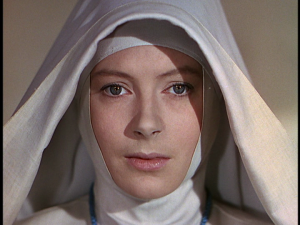
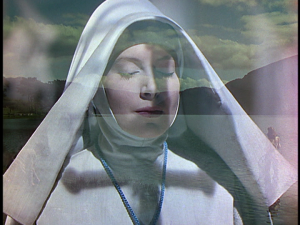
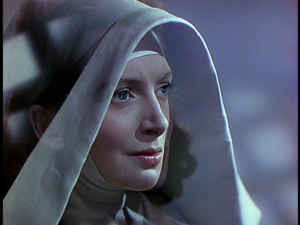
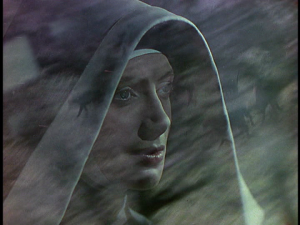
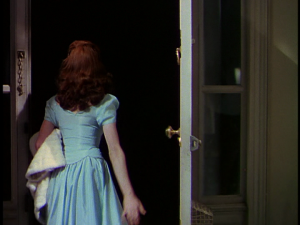
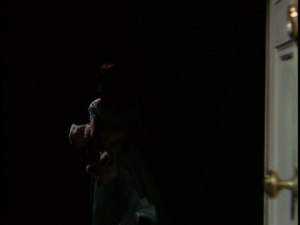

What a great read Colin. I hadn’t even thought of this Reverse Oz effect, though I’d initially thought the opening of the convent doors with the billowing habit would function as a Wizard of Oz, color entrance. and “arrestingly unclear” is just right about Sister Clodagh in general.
I’ve never been a total devotee of Deborah Kerr but this performance really wowed me. My favorite piece of the entire performance is the way she shifts out of this initial flashback reverie (not the shot itself — which I covered) but the way she smiles but is suddenly self aware and glancing to the side. Is she concerned that people are seeing her, or is she disturbed by something in them she sees. It’s…
arrestingly…
well you get it.
I love your post.
1Thanks for the kind compliment! The opening of the convent doors caught me pleasantly off-guard, much like The Piano‘s abrupt, economical shot of the boat cleaving water, and I would have thought of juxtaposing it with the “reverse Oz” shot if I hadn’t chosen to focus on Sister Clodagh instead. Kerr’s performance is surely one for the ages, especially since cinema offers us so few priest/nun roles to begin with that really stress how difficult and noble it can be, because they’re just human like us all.
2Loving your write-up too. It’s like Deborah Kerr is telling the story with her performance/face.
3Thanks, Paolo. And I love how “performance” and “face” are nearly interchangeable here for Kerr, since she spends most of her screentime in that wimple and habit. But let’s not give short shrift to her sprightly, Dorothy-ish take on her younger days, either =)
4